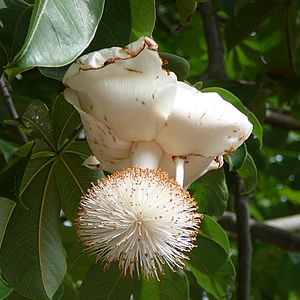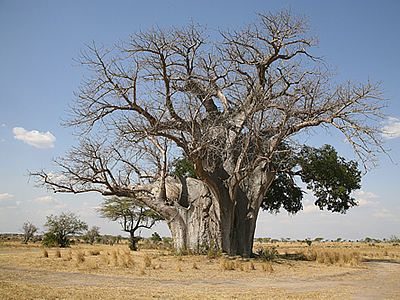
The Baobab (Adansonia digitata) is a majestic, deciduous tree of substantial size, easily reaching heights of 25 meters (about 82 feet) and a diameter of 6 meters (nearly 20 feet). Native to Central Africa, from south of the Sahara to the northern Transvaal region in South Africa, it has now spread worldwide across various tropical regions. Its trunk is cylindrical, robust, with a spongy interior that acts as a significant water reservoir, capable of storing thousands of liters.
The tree is highly branched, with branches either near its base or only at the top. A common impression, especially when leafless, is that it looks “upside down” due to its intricate branches resembling a root system. The leaves emerge late in spring and are palmate, divided into five to seven elliptical leaflets. In winter, the tree completely sheds its leaves.
Its flowers are large, hanging, and stunningly beautiful, white in color with recurved petals and numerous stamens. When they first bloom, they have a sweet scent, but over time they develop a peculiar unpleasant odor, reminiscent of carrion. These flowers last for one to two days and are pollinated by fruit bats. The ensuing fruits, known as Mukua, are oval, with a brown shell covered by a thin layer of hair. Their pulp is pasty when moist and powdery once dry, ivory-white in color. It’s sweet, edible, nutritious, and encases the seeds, which are brownish and kidney-shaped.
The baobab is a species shrouded in many legends and holds intense religious significance, with its cutting being prohibited within the culture and religion of Candomblé, among other African religions. The baobab is also an extremely versatile tree. It can serve as a water reserve, food source (fruits and leaves), medicinal plant, bee-friendly, and even as shelter. In Africa, baobabs can be found serving as homes, sanctuaries, bars, bathrooms, prisons, and even bus stops.

Its growth is slow, and it is very long-lived, but its use in landscaping is rewarding due to its striking presence. It is ideal for planting in spacious areas, such as farms and public parks, where its sculptural trunk and exposed roots can develop without damaging buildings or buried pipelines.
It should be grown in full sun, in well-drained soil, preferably enriched with organic matter and fertile, although it can thrive even in poor soils. Native to semi-arid and coastal regions, it tolerates salinity well and, once well-established, is drought-resistant. Incredibly, it is also fire-resistant, surviving even when its interior is destroyed by flames. It reproduces by seeds.


